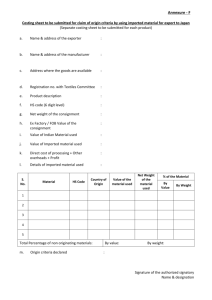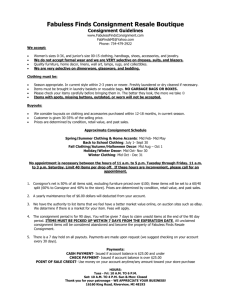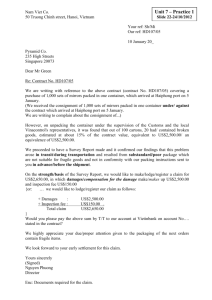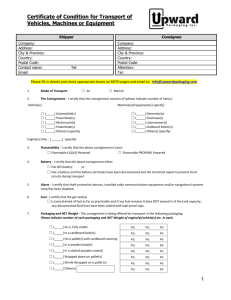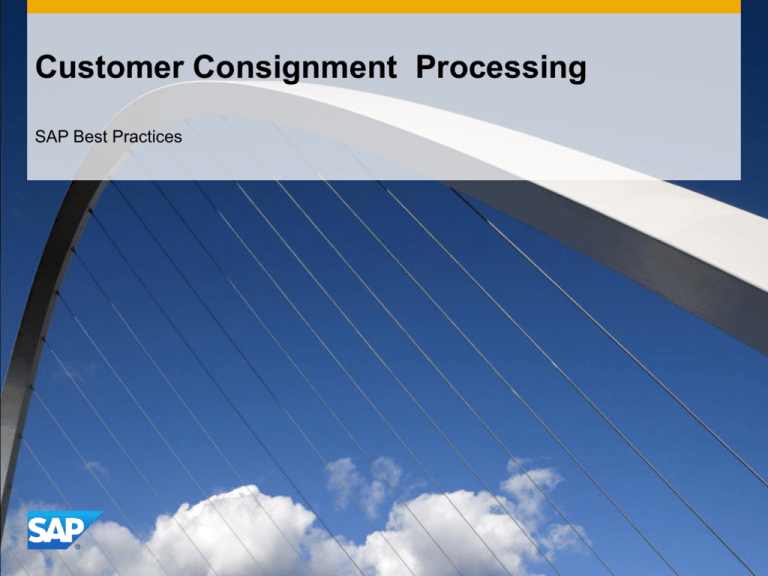
Customer Consignment Processing
SAP Best Practices
Purpose, Benefits, and Key Process Steps
Purpose
Consignment goods are goods which are stored at the customer location but which are
owned by your company. The customer is not obliged to pay for these goods until they
remove them from consignment stock. Otherwise, the customer can usually return
consignment goods which are not required.
Benefits
Consignment stock managed separately for each customer
Consignment stock managed separately from the rest of your stock
Key Process Steps
Consignment Fill-Up
Consignment Issue
Consignment Pick-Up
Consignment Return
Pick and Ship
Billing
© 2011 SAP AG. All rights reserved.
2
Required SAP Applications and Company Roles
Required SAP Applications
Enhancement package 5 for SAP ERP 6.0
Company Roles
Sales Administrator
Warehouse Clerk
Billing Administrator
Accounts Receivable Manager
© 2011 SAP AG. All rights reserved.
3
Detailed Process Description
Customer Consignment Processing
There are four main transactions for processing consignment stock in the SAP ERP
System, all of which support separate management of stock:
Consignment Fill-up
Consignment fill up is used to supplement the customer’s consignment stock. Goods
issue of the appropriate stock is posted from the unrestricted-use stock to consignment
stock (special stock). The goods remain in the possession of the vendor.
Consignment Pick-Up
Any consignment goods stored at the customer’s warehouse that haven’t been used can
be reposted to your company’s warehouse with a consignment pick-up.
If the customer returns consignment stock to you, you record the transaction in the
system by creating a consignment pick-up order (order type KA). As a result, the system
carries out the following actions:
When goods issue is posted, the relevant quantity is deducted from the customer’s
special stock and is added back into your regular stock at the plant where the goods are
returned. Your total valuated stock remains the same since the returned stock was
regarded as part of your own inventory even while it was at the customer’s premises.
This transaction is not relevant for billing.
© 2011 SAP AG. All rights reserved.
4
Detailed Process Description
Customer Consignment Processing
Consignment Issue
Consignment issue enables the customer to take consignment goods from the
special stock for their use or to sell.
Consignment issue involves removing the goods from the special stock and making
it the property of the customer.
When the customer removes consignment stock to use or sell, you record the
transaction in the system by creating a consignment issue order.
Consignment Return
Consignment returns are used for when your customer wants to return goods to the
consignment stock.
If the customer wishes to claim on consignment goods which have already been
issued, you can record this transaction by creating a consignment return order.
© 2011 SAP AG. All rights reserved.
5
Process Flow Diagram
Need to
Purchase
Consignment
Goods
Daily Shipment
Worklist,
Enough
Inventory
Order
Confirmation
Delivery Note
Bill of Lading
Consignment
Fill-Up Sales
Order Entry
Warehouse Clerk
Sales
Administrator
Customer
Event
Customer Consignment Processing – Consignment Fill-Up
© 2011 SAP AG. All rights reserved.
Delivery Due
List
Picking
Check Batches
/ Assign Serial
Number
(optional)
Post Goods
Issue
End Process
Delivery Pick
List
6
Process Flow Diagram
Customer Consignment Processing – Consignment Issue
(Optional)
Sales:
Period End
Closing
Operations
(203)
Daily Shipment
Worklist,
Enough
Inventory
Accounts
Receivable
(157)
Consignment
Issue Order
Entry
Accounts
Receivable
Billing
Administrato Warehouse
Clerk
r
Sales
Administrator
Event
Goods Issue
from
Consignment
© 2011 SAP AG. All rights reserved.
Delivery Due
List
Assign
Batches &
Serial
Numbers
Post Goods
Issue
Billing
Invoice
End Process
7
Process Flow Diagram
Customer Consignment Processing – Consignment Pick-Up
Daily Shipment
Worklist,
Enough
Inventory
Consignment
Pick-Up Sales
Order Entry
Warehouse Clerk
Sales Administrator
Event
Need to Send
Back
Consignment
Stock
© 2011 SAP AG. All rights reserved.
Delivery Due
List
Assign
Batches &
Serial
Numbers
Post Goods
Receipt
End Process
8
Process Flow Diagram
Customer Consignment Processing – Consignment Return
(Optional)
Sales:
Period End
Closing
Operations
(203)
Daily shipment
worklist,
enough
inventory
Accounts
Receivable
(157)
Consignment
Return Order
Entry
Assign
Batches &
Serial
Numbers
Post Goods
Receipt
Billing
Administrator
Delivery Due
List
Billing
Release Billing
Documents for
Accounting
Accounts
Receivabl
e
Warehouse
Clerk
Sales
Administrator
Event
Return into
Consignment
Stock
Release
Consignment
Return Order
for Billing
Credit Note
© 2011 SAP AG. All rights reserved.
End Process
9
Legend
<Function>
Symbol
Description
Usage Comments
Band: Identifies a user role, such as Accounts
Payable Clerk or Sales Representative. This band
can also identify an organization unit or group,
rather than a specific role.
Role band contains
tasks common to that
role.
Symbol
Diagram
Connection
The other process flow symbols in this table go
into these rows. You have as many rows as
required to cover all of the roles in the scenario.
External
to SAP
External Events: Contains events that start or end
the scenario, or influence the course of events in
the scenario.
Business
Activity / Event
Unit Process
Process
Reference
SubProcess
Reference
Process
Decision
Usage Comments
To next / From last Diagram: Leads
to the next / previous page of the
Diagram
Flow chart continues on the next /
previous page
Hardcopy / Document: Identifies a
printed document, report, or form
Does not correspond to a task
step in a document; instead, it is
used to reflect a document
generated by a task step; this
shape does not have any outgoing
flow lines
Financial Actuals: Indicates a
financial posting document
Does not correspond to a task
step in a document; instead, it is
used to reflect a document
generated by a task step; this
shape does not have any outgoing
flow lines
Budget Planning: Indicates a
budget planning document
Does not correspond to a task
step in a document; instead, it is
used to reflect a document
generated by a task step; this
shape does not have any outgoing
flow lines
Manual Process: Covers a task
that is manually done
Does not generally correspond to
a task step in a document;
instead, it is used to reflect a task
that is manually performed, such
as unloading a truck in the
warehouse, which affects the
process flow.
Existing Version / Data: This block
covers data that feeds in from an
external process
Does not generally correspond to
a task step in a document;
instead, this shape reflects data
coming from an external source;
this step does not have any
incoming flow lines
System Pass / Fail Decision: This
block covers an automatic
decision made by the software
Does not generally correspond to
a task step in the document;
instead it is used to reflect an
automatic decision by the system
that is made after a step has been
executed.
Hardcopy /
Document
Flow line (solid): Line indicates the normal
sequence of steps and direction of flow in the
scenario.
Flow line (dashed): Line indicates flow to
infrequently-used or conditional tasks in a
scenario. Line can also lead to documents involved
in the process flow.
Connects two tasks in
a scenario process or
a non-step event
Business Activity / Event: Identifies an action that
either leads into or out of the scenario, or an
outside Process that happens during the scenario
Does not correspond
to a task step in the
document
Unit Process: Identifies a task that is covered in a
step-by-step manner in the scenario
Corresponds to a task
step in the document
Financial
Actuals
Process Reference: If the scenario references
another scenario in total, put the scenario number
and name here.
Corresponds to a task
step in the document
Sub-Process Reference: If the scenario references
another scenario in part, put the scenario number,
name, and the step numbers from that scenario
here
Corresponds to a task
step in the document
Process Decision: Identifies a decision / branching
point, signifying a choice to be made by the end
user. Lines represent different choices emerging
from different parts of the diamond.
Does not usually
correspond to a task
step in the document;
Reflects a choice to
be made after step
execution
© 2011 SAP AG. All rights reserved.
Description
Budget
Planning
Manual
Process
Existing
Version /
Data
System
Pass/Fail
Decision
10
© 2011 SAP AG. All rights reserved
No part of this publication may be reproduced or transmitted in any form or for any purpose
without the express permission of SAP AG. The information contained herein may be
changed without prior notice.
Some software products marketed by SAP AG and its distributors contain proprietary
software components of other software vendors.
Microsoft, Windows, Excel, Outlook, and PowerPoint are registered trademarks of Microsoft
Corporation.
IBM, DB2, DB2 Universal Database, System i, System i5, System p, System p5, System x,
System z, System z10, System z9, z10, z9, iSeries, pSeries, xSeries, zSeries, eServer,
z/VM, z/OS, i5/OS, S/390, OS/390, OS/400, AS/400, S/390 Parallel Enterprise Server,
PowerVM, Power Architecture, POWER6+, POWER6, POWER5+, POWER5, POWER,
OpenPower, PowerPC, BatchPipes, BladeCenter, System Storage, GPFS, HACMP,
RETAIN, DB2 Connect, RACF, Redbooks, OS/2, Parallel Sysplex, MVS/ESA, AIX,
Intelligent Miner, WebSphere, Netfinity, Tivoli and Informix are trademarks or registered
trademarks of IBM Corporation.
Linux is the registered trademark of Linus Torvalds in the U.S. and other countries.
Adobe, the Adobe logo, Acrobat, PostScript, and Reader are either trademarks or
registered trademarks of Adobe Systems Incorporated in the United States and/or other
countries.
Oracle is a registered trademark of Oracle Corporation.
UNIX, X/Open, OSF/1, and Motif are registered trademarks of the Open Group.
Citrix, ICA, Program Neighborhood, MetaFrame, WinFrame, VideoFrame, and MultiWin are
trademarks or registered trademarks of Citrix Systems, Inc.
HTML, XML, XHTML and W3C are trademarks or registered trademarks of W3C®, World
Wide Web Consortium, Massachusetts Institute of Technology.
Java is a registered trademark of Sun Microsystems, Inc.
JavaScript is a registered trademark of Sun Microsystems, Inc., used under license for
technology invented and implemented by Netscape.
Business Objects and the Business Objects logo, BusinessObjects, Crystal Reports, Crystal
Decisions, Web Intelligence, Xcelsius, and other Business Objects products and services
mentioned herein as well as their respective logos are trademarks or registered trademarks
of Business Objects Software Ltd. Business Objects is an SAP company.
Sybase and Adaptive Server, iAnywhere, Sybase 365, SQL Anywhere, and other Sybase
products and services mentioned herein as well as their respective logos are trademarks or
registered trademarks of Sybase, Inc. Sybase is an SAP company.
All other product and service names mentioned are the trademarks of their respective
companies. Data contained in this document serves informational purposes only. National
product specifications may vary.
The information in this document is proprietary to SAP. No part of this document may be
reproduced, copied, or transmitted in any form or for any purpose without the express prior
written permission of SAP AG.
This document is a preliminary version and not subject to your license agreement or any
other agreement with SAP. This document contains only intended strategies, developments,
and functionalities of the SAP® product and is not intended to be binding upon SAP to any
particular course of business, product strategy, and/or development. Please note that this
document is subject to change and may be changed by SAP at any time without notice.
SAP assumes no responsibility for errors or omissions in this document. SAP does not
warrant the accuracy or completeness of the information, text, graphics, links, or other items
contained within this material. This document is provided without a warranty of any kind,
either express or implied, including but not limited to the implied warranties of
merchantability, fitness for a particular purpose, or non-infringement.
SAP shall have no liability for damages of any kind including without limitation direct,
special, indirect, or consequential damages that may result from the use of these materials.
This limitation shall not apply in cases of intent or gross negligence.
The statutory liability for personal injury and defective products is not affected. SAP has no
control over the information that you may access through the use of hot links contained in
these materials and does not endorse your use of third-party Web pages nor provide any
warranty whatsoever relating to third-party Web pages.
SAP, R/3, SAP NetWeaver, Duet, PartnerEdge, ByDesign, SAP BusinessObjects Explorer,
StreamWork, and other SAP products and services mentioned herein as well as their
respective logos are trademarks or registered trademarks of SAP AG in Germany and other
countries.
© 2011 SAP AG. All rights reserved.
11

